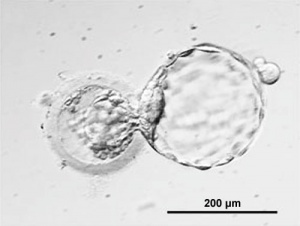K12 Stem Cells: Difference between revisions
| (9 intermediate revisions by the same user not shown) | |||
| Line 29: | Line 29: | ||
--[[User:Z8600021|Mark Hill]] 09:25, 11 October 2012 (EST) | --[[User:Z8600021|Mark Hill]] 09:25, 11 October 2012 (EST) | ||
|} | |} | ||
==The Nobel Prize in Physiology or Medicine 2012== | |||
Awarded jointly to [[Embryology_History_-_John Gurdon|'''Sir John B. Gurdon''']] and [[Embryology_History_-_Shinya_Yamanaka|'''Shinya Yamanaka''']] "''for the discovery that mature cells can be reprogrammed to become pluripotent.''" | |||
{| | |||
| colspan=2|John Gurdon (a UK scientist) in the 1960's used a frog egg and cells from an adult frog to show that the adult cell nucleus can replace the egg nucleus and then develop normally into a tadpole then frog. | |||
| | |||
|- | |||
| [[File:Frog_eggs.jpg|150px|Frog Eggs]] | |||
| [[File:Frog-icon.png|150px|Adult Frog]] | |||
|- | |||
| Frog Eggs | |||
| Adult Frog | |||
|} | |||
* Shinya Yamanaka (a Japanese scientist) in 2006 identified just 4 proteins are required to turn any cell into a stem cell. | |||
[[Stem_Cells_-_Induced|Induced Stem Cells]] | |||
==University Level Information== | ==University Level Information== | ||
| Line 49: | Line 69: | ||
{{External Links}} | {{External Links}} | ||
* Boston Childrens Hospital - [http://stemcell.childrenshospital.org/about-stem-cells/history/| Stem Cell Timeline] | |||
{{Footer}} | {{Footer}} | ||
Latest revision as of 09:08, 11 October 2012
Introduction
| Everywhere in the news today you here the word "Stem Cell", it appears in the news of science, medicine, politics, religion, ethics, law and just recently as the 2012 Nobel Prize.
The Nobel Prize in Physiology or Medicine 2012Awarded jointly to Sir John B. Gurdon and Shinya Yamanaka "for the discovery that mature cells can be reprogrammed to become pluripotent."
University Level Information
Embryonic Stem Cells
Adult Stem CellsInduced Stem CellsExternal LinksExternal Links Notice - The dynamic nature of the internet may mean that some of these listed links may no longer function. If the link no longer works search the web with the link text or name. Links to any external commercial sites are provided for information purposes only and should never be considered an endorsement. UNSW Embryology is provided as an educational resource with no clinical information or commercial affiliation.
Cite this page: Hill, M.A. (2024, April 19) Embryology K12 Stem Cells. Retrieved from https://embryology.med.unsw.edu.au/embryology/index.php/K12_Stem_Cells
|
|||


